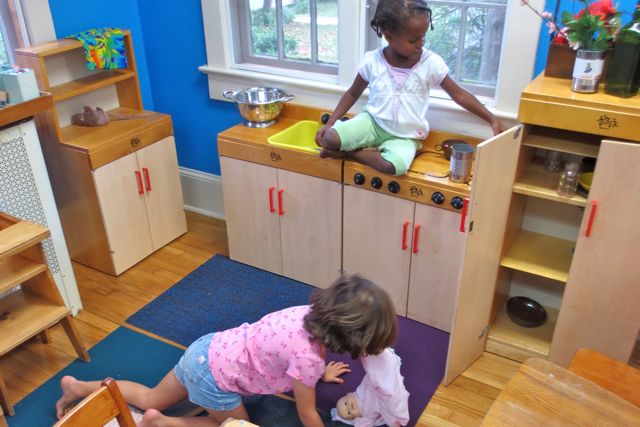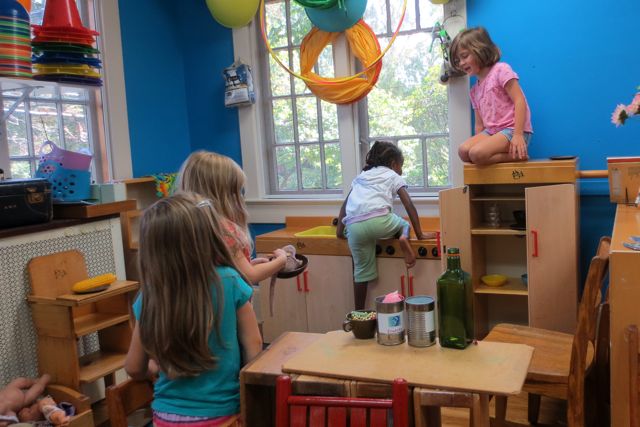What makes it a problem?
"You can't have girl-only sections," one of the boys said to the three girls standing along the wall. All three gave him the same look and one of them pointed across to the other wall and said, "That's the boy's."
He stood his ground, standing in the middle, while all around the children fell into line around him, girls on one side, boys on the other, but not for long. Once gathered, the first group was ready for their dramatic play session and they tumbled into the room in a rush of arms and legs only to arrange themselves -- surprise -- in a loop of girls and a loop of boys.
So I wondered...During our pre-meeting for dramatic play, I didn't call their attention to how they were sitting or remind them about the only-sections from just seconds before. In any case, they were like racehorses at a starting gate like they always are before a dramatic play session. TIME TO PLAY! I told them there was not a moment to waste but that I needed the table to mount their artwork. There was a moment of negotiation because a representative from girl/loop said they NEEDED the table for "cat family". I asked them if they could build one out of blocks, they looked at each other and nodded. They said they would need four blocks and a flat piece to make the table, they scooped those away and off they went. The girl section to play cat family and the boy to play "any-kind-of-ship." I went to the table to mount artwork -- better to watch and listen, my dears.
The Play. First Session.
Reflection. First Session.
In the 40-ish minutes, they never crossed lines. Not once. Once the blocks were cleared and the cat toys and milk dishes were sorted, we settled in for our post-dramatic play check-in. I reminded them about the girl and boy sections from before and then I described their play. I did not photograph their faces, but let me just tell you that they showed a mixture of "Really?" and "Are you sure?" kind of facial expressions. I asked them, "Is playing with just boys or just girls a problem?"
They offered instances when it was okay and when it was not okay. Bottom line: If you tell someone she or he cannot play BECAUSE <blank> then it is a problem. The <blank> included all kinds of things, not just gender. In addition to gender they listed reasons from "if you have a unicorn (or not)" to "if you like soldiers (or not)."
The next crew came in and they sat settled in for their pre-meeting. I told them about what --not how-- the other group played, "There was a cat family over there and they built an any-kind-of-ship here." There were nods of approval for the play pursuits and "I will be the cat mother" talk. I added that I had to finish mounting the artwork and that I needed the table, but the cat family left the table they built out of blocks. So play! Off they went. Would the gender lines hold?
The Play. Second Session.
Reflection. Second Session.
"The last group played with only-girls in the cat-family and only-boys in the ship-building. How did you play?" They looked at each other. While the loops they were sitting in mirrored the play groups from earlier, they were indeed sitting in a loop of girls and a loop of boys. "I only played with girls," one of the cat family members answered. And this was true. One of the ship builders answered, "I only played with boys." But if you look at the photographs, you will see that this is not true. The photographs collected here do not show that one of the girls was playing both cat family AND ship-building-cleaning. I described that to them and they all nodded solemnly. I posed the question to them, "Is playing with just boys or just girls a problem?" They arrived at the same answers, but naturally with different examples of <blank> that were unique to this particular group's interests.
Later, I thought about how when I was new to teaching, I would have forced some kind of shake-up of the gender divide. As I completed my studies and watched the arc of growth and development, I learned that it is best to simply make the obvious evident through reflection and discussion WITH children rather than alone through adult perceptions of a situation.
Ask and learn. Things we may perceive as a problem may not be one at all.
Following all this play and reflection, the children again tumbled, all arms and legs, outside. And there, the gender lines became fuzzy and melted mostly away as children found their spaces and places to play.







